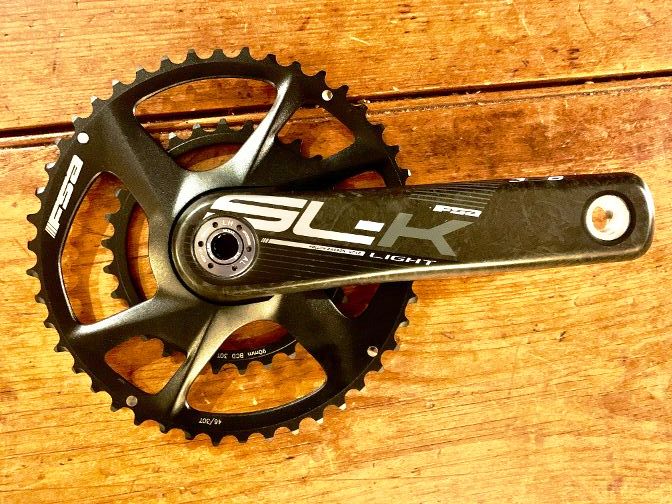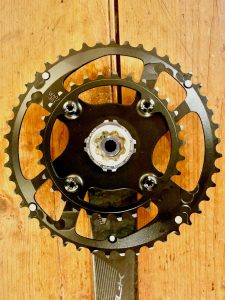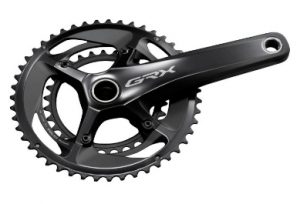SUBCOMPACT 2X ROAD CRANKSETS: A BRIEF ANALYSIS. IS 46/30 GEARING RIGHT FOR YOU?
The latest crop of gravel specific road drivetrains offer lower gearing than a typical road bike. Groups like Shimano GRX, SRAM Force AXS Wide and Campagnolo Ekar are designed to help you deal with steep dirt roads with loose surfaces as best as possible through wide range gearing. In the case of 2x gravel groups, the new “sub-compact” cranksets have smaller chainrings than the common 50/34 compact rings many road bike come with. New gravel friendly road cranksets include the 46/30 Rotor, 46/30 FSA Adventure, 48/32 Praxis Zayante, the 46/30 Shimano GRX RX FC600 and the 48/31 Shimano GRX FC-RX810. How do you know if this lower gearing is for you?
 A Brief History of the Compact Crankset
A Brief History of the Compact Crankset
Back in the old days (pre 2000), there was no such thing as a gravel road bike, nor gravel road drivetrains. Road cranksets typically had a chainring combination of a 52 or 53 outer chainring and a 42 or 39-tooth inner ring. It was around 2003 that the modern compact crankset (50/34 combination) was introduced. The first one I remember was made by Full Speed Ahead (FSA); my wife and I put FSA’s offering on our road bikes to help conquer Mont Ventoux in 2004. Soon after, compact gearing became the dominant road and gravel configuration.
While 50/34 was a big improvement, as time marched on and more people started exploring steep and loose gravel road riding, the desire for even lower gearing arose. Around 2017, Praxis Works came out with a 48/32 combination on its Zayante crankset. Similar options from FSA and others were released around the same time and, by 2020, Shimano and SRAM released groups specific to gravel based riding and these included 30 or 31 tooth inner rings.
How the High Gear on a Subcompact Crankset Relates to Compact Gearing
So, what is gained and what is lost by going from a 50 tooth big chainring to a 46 tooth?
While crank length and tire diameter are also variables, gear inches are roughly the distance the bike will travel in a given gear combination for a single revolution of the crank. According to Sheldon Brown’s website, a 50-11 front-rear gear combination results in a gear inches measurement of 119.9. By comparison, a 46-11 combination = 113.6 gear inches.
The larger the number, the higher the gear ratio and the more speed at a given cadence. Thus the 46-11 is not as high as the 50-11, but is a bit higher than a 50-12 with its 109.7 gear inch. Few gravel riders, will find themselves “spinning out” with a 46-tooth outer chainring. In fact, it will take a strong rider on pavement to spin out a 46-11 in many cases.
In exchange for giving up your highest gear, you can gain significant climbing gears on the other end.
How the Low Gear on a Subcompact Crankset Relates to Compact Gearing
 When it comes to the low gears, the lower the gear inch number, the lower (and easier to climb) the gear. With compact gearing, Shimano’s lowest manufacturer sanctioned cassette is 11-34. When combined with the 34 tooth inner of the compact 50/34 crankset, a “1:1” (34:34) is the result, with gear inch measurement of 27.2. Keeping the cassette the same, but swapping in the 30 tooth inner ring of the 46/30 Shimano sub-compact GRX 600 crankset and the gear inches are 24 – a reduction of 3.2 gear inches. This almost 12% difference is the equivalent of adding four teeth in cassette; switching the 11-34 cassette to a 11-38 (note that Shimano does not offer such a cassette).
When it comes to the low gears, the lower the gear inch number, the lower (and easier to climb) the gear. With compact gearing, Shimano’s lowest manufacturer sanctioned cassette is 11-34. When combined with the 34 tooth inner of the compact 50/34 crankset, a “1:1” (34:34) is the result, with gear inch measurement of 27.2. Keeping the cassette the same, but swapping in the 30 tooth inner ring of the 46/30 Shimano sub-compact GRX 600 crankset and the gear inches are 24 – a reduction of 3.2 gear inches. This almost 12% difference is the equivalent of adding four teeth in cassette; switching the 11-34 cassette to a 11-38 (note that Shimano does not offer such a cassette).
Forget Gear Inches and Ratios. What Does this Really Mean for My Riding?
Are sub-compact cranksets only for use on gravel roads? For many riders, the answer is, “No.” To find out, ask yourself this simple question: “How much time do I spend in the highest 50-11 tooth combination?” If your answer is that you use the 50-11 somewhat regularly, stop reading and stick with your current gearing. However, if your answer is, “Almost never”, read on.
At the risk of some accusing me of heresy, I would dare say moving to a 46/30 subcompact crankset has very few disadvantages for many road riders. Subcompact is not all about getting a lower hill climbing gearing. Subcompact can allow stronger riders, or riders on flatter terrain, to focus on a cassette with tighter gearing jumps. For example, if a rider normally rides an 11-28 cassette, having a 46/30 chainring combination could allow them to move to an 11-25 cassette without giving up their lowest climbing gear.
Additional Subcompact Crank Gearing Options
For those who may find this worth considering but feel that a 46-tooth front chainring is unacceptably low, they might consider the Shimano GRX FC-RX810 crankset, with a 48/31 gear combination. This combination will provide a higher top end than a 46, while the 31-tooth chainring will offer a climbing gear that is just slightly higher than a 30. Or maybe consider the various offerings by Shimano, Praxis, FSA, Rotor, etc., of a 48/32 combination. As you can see, there are a lot of options that allow riders to tailor their gearing to specific desires.
Subcompact Front Derailleur Caveats
 If a 48/31 subcompact sounds appealing, remember that most front derailleurs are designed to work best with a maximum chainring difference of 16 teeth, i.e. 50 – 34 = 16, 48 – 32 = 16, or 436 – 30 = 16. If you switch to a Shimano RX810 48/31 crankset you may want to replace your front derailleur with the Shimano GRX FD-RX810 front derailleur, designed to work with a 17-tooth difference, for maximum front shifting performance.
If a 48/31 subcompact sounds appealing, remember that most front derailleurs are designed to work best with a maximum chainring difference of 16 teeth, i.e. 50 – 34 = 16, 48 – 32 = 16, or 436 – 30 = 16. If you switch to a Shimano RX810 48/31 crankset you may want to replace your front derailleur with the Shimano GRX FD-RX810 front derailleur, designed to work with a 17-tooth difference, for maximum front shifting performance.
It is also worth being aware that many of these gravel inspired subcompact cranksets also adhere to the new “wide” standard. The chainrings sit 2.5mm further out than a standard road compact crankset. With some frames, this difference alone will require that a wide derailleur be used in conjunction. Sometimes some experimentation at the shop level is necessary to figure out how things will work.
Subcompact Crank Conclusions
If you want a lower climbing gear, or tighter gear jumps, one of the several subcompact cranksets on the market could be a great option for you. Many riders will get undeniable climbing benefits with minimal disadvantages changing from a 50/34 to a 46/30.
Regardless, make sure your bike is fit properly to your body and that you use equipment and components that best serve your needs, where your ride, and your riding style.
For additional information on gearing options, bike fitting and today’s bikes, contact Fit Werx.

